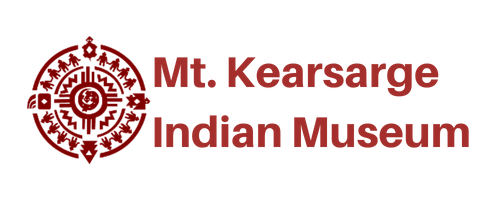2025: Sights & Sounds of Powwow
This multi-sen
2024: Baskets ~ Carriers of Life and Spirit
This multi-sensory experience was curated by members of our Native community alongside dedicated museum staff and showcases the timeless beauty of ash splint and sweetgrass baskets woven for a variety of purposes, to not only carry the everyday materials of life, but also to hold within the intention and legacy of the artists who continue to craft them. See how raw resources from nature are transformed into beautiful baskets, smell the fresh fragrance of sweetgrass, and feel with your own hands the very items that have been a part of this artistic tradition for generations.
“These baskets are imprinted with the substance and spirit of the basket makers, as surely as the oil and salt from their fingers are embedded in the process.”
2023: Nebizun: Water is Life
Nebizun (alternately spelled Nebizon) is the Abenaki word for medicine and the root word Nebi is the Abenaki word for water. The rivers and tributaries of N’Dakinna (our homeland) were our highways for traveling and the water itself is important to the species of fish and other wildlife that is necessary to our way of life. As stewards of the environment Native American people know the importance of having clean water. The Abenaki people know and understand the importance of water in everyday activities related to foodways and healing powers of water. Nebizun: Water is Life draws its inspiration from Native American Grandmothers who have been doing water walks to pray for the water, and the 50th anniversary of the Clean Water Act.
This exhibit was curated in partnership with the Vermont Abenaki Artists Association and the Abenaki Arts & Education Center and was made possible by NH Humanities - Community Project Grants.
2023: Shaping Traditions: Pueblo Pottery
Pottery making has been a time-honored tradition that provides insight into the identity of the Pueblo communities. The craft is time-consuming and unforgiving, with artists spending up to ten hours a day making pottery, often creating small pieces that will be sold.
Each Pueblo creates their pottery with unique qualities and personal touches that showcase their individual identities. Some designs speak of traditional patterns full of meaning, while others are pure experiments in the process of furthering the art for modern audiences. Certain designs and techniques are the trademark of a particular family, passed down for generations through observation and oral instruction.
For Pueblo communities, the act of making pottery goes far beyond a simple sales transaction — it becomes a model for teaching, an opportunity for familial and communal bonding, and a way of bringing the legacies of their ancestors into modern practice.
2022: 100 Years of Hopi Katsina Carvings
The exhibit is currently featured in our Southwest Gallery and comes from the collection of Chuck and Debra Douglas. Their generous donation of katsinam is greatly appreciated. Traditionally, these figures have been used as teaching tools. They are the carved representation of the Katsinam, the spirit messengers of the universe.
2019: The Journey
“The Journey” integrates the spiritual paintings and fine art sculpture of Arthur “Bud” Thibault (Lakota) and Jim Sawdey Smith, “Strongbear” (Mohawk heritage). When talking about the exhibit, Bud says, “We’re all on a different road. We take it. Find a path with a heart in it, and walk that path.”
Bud Thibault is a graduate of Mass Art. As a Native artist, Bud feels obliged to record for future generations some of the ceremonies, myths, and legends of the Lakota People.
Strongbear (1948-2012) attended St. Augustine School of Fine Art. He recorded his journey - including serving as a Marine in Vietnam, struggling with throat cancer, and his ancestry - through daily paintings.
2019: Babaskwahomwôgan: The Spirit Game
Lacrosse, Little Brother of War, or The Spirit Game...No matter what you call it, the game require the players to have great skill and demonstrate physical prowess. Babaskwahomwôgan:The Spirit Game brings together a collection of traditional and modern Lacrosse sticks, with family images of players and the original artwork from the book Swift Deer’s Spirit Game. Watercolor paintings by Francine Poitras Jones bring the game and a village to life.
2018: Closing the Gap
Despite the great physical distance, Jacob “Yellow Eagle” Ginga and his mother, Faith “Wildflower” Bullock, create beautiful and aesthetically similar artwork. In this exhibition, each artist created individual work inspired by their Native Heritage while also working collaboratively on a series of paintings. Both artists favor wood as a painting surface, Faith often manipulated the wood into feather shapes before adorning them with colorful patterns and striking designs, while on the other side Jacob creates abstract but intricate portraits with vibrant colors and a combination of Native and Contemporary design influences. In between the two individual artist’s work is the collection of paintings created collaboratively, each work having traveled thousands of miles from Stonewall, TX to New Bedford,MA and back several times before completion. This exhibition represents the work of two Native artists, a mother and a son, sharif their passion and connection, and closing the gap between them.
2017: Alnobak: Wearing Our Heritage
What does it mean to be an Abenaki person in the modern world? What does it mean to be an Indigenous artist? Native identity finds expression in different ways with each generation. Wearing Our Heritage showcased objects and images that document the way in which garments and accessories that reflect Abenaki heritage have been and still are made and used to express Native identity. These objects are made and worn for self-affirmation, to affirm connections with family, clan, band and tribe, and to express identity within the geographical locale co-occupied with mainstream culture.
This special traveling exhibition developed through a partnership of the Vermont Abenaki Arts Association and the Lake Champlain Maritime Museum, and guest curator, Vera Longtoe Sheehan.
“Identity is a negotiation between what others expect of you and what you expect of yourself,”
- Frederick M. Wiseman, Ph. D., Abenaki scholar and activist
